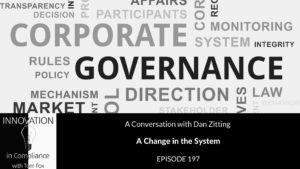
Dan Zitting, previously Chief Product Officer, now holds the title of CEO at Galvanize, a software company that helps its clients achieve their goals and objectives. Tom Fox welcomes him back to this week’s show to talk about fraud risks, and what it means for the compliance professional.
A Period of Change
Rapid change during the pandemic is the main catalyst for the increase in fraud. The move to remote work created new susceptibility to cyber fraud. “The pandemic and the news, and noise created around it, created all kinds of new ways for clever social engineers to talk people into doing things they shouldn’t be doing,” Dan explains to Tom. It’s important for GRC professionals to be aware of and ready for change, he adds. We have to realize that change has sped up and will continue to do so in the business environment, regulatory environment, and social justice areas. The rate at which change will increase will be much greater in the future than it has been in the past.
Choosing The Right Technology
Choosing the right technology to support anti-fraud programs is important. GRC professionals have to shift controls and assess risk fast enough to deal with all the changes that are occurring around them. Having the proper technology on hand can help make their jobs easier. “A lot of technology is effectively built around manually filling out forms, and creating workflows between people to capture risk or assess risk or evaluate controls, and that is just far too slow-moving,” Dan remarks. We need to create automation primarily from data and technology that can evaluate very quickly. We also need to be able to leverage machine learning which will help us identify data that we might not have otherwise known.
Fraud as a Bigger Focus & The Importance of Governance
How fraud connects to the broader array of cybersecurity risks makes it a major focus for CEOs and senior executives. Leaders are seeking to learn more and educate themselves on how compliance officials are analyzing and monitoring the risks, something that was not done as often in the past. Interest in governance within the compliance sector is also gaining headway. Dan explains to Tom that organizations need to have overarching governance strategies that dictate how they look at the incoming risks to the business.
Resources
Dan Zitting | LinkedIn | Twitter
Galvanize





